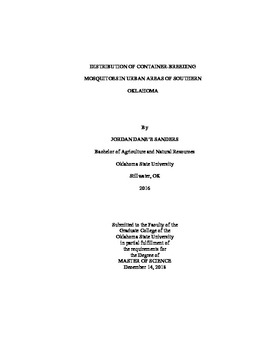| dc.contributor.advisor | Noden, Bruce H. | |
| dc.contributor.author | Sanders, Jordan Dane'e | |
| dc.date.accessioned | 2019-07-19T14:49:23Z | |
| dc.date.available | 2019-07-19T14:49:23Z | |
| dc.date.issued | 2018-12-01 | |
| dc.identifier.uri | https://hdl.handle.net/11244/320996 | |
| dc.description.abstract | Aedes aegypti, the yellow fever mosquito, is a significant arbovirus vector worldwide and one that has gained prominence recently in the US as a primary vector for Zika virus. In 2016, A. aegypti was discovered again in four cities in southern Oklahoma during surveillance activities along with other important container-breeding species, namely Aedes albopictus and Culex pipiens complex. While pockets of A. aegypti in several Oklahoma cities were identified, there is limited understanding of the nature and extent of these populations within given urban areas or regions of the state. In this study, we hypothesized that A. aegypti were more likely to occur in the southern part of the state and were more likely to become established within regional urban areas. Between May to August 2017, mosquitoes were collected in six urban areas along two transects in central and western Oklahoma between the Red River (Texas border) and cities 60 miles from the border. Bi-weekly mosquito collection (total 2,118 trap nights) utilized Gravid Aedes traps (GAT) and BG-sentinel traps across urban gradients. With the use of geographical information systems (GIS), predictions of mosquito density in relation to vegetation, container availability and other anthropogenic factors were determined within urban habitats. Of the 6,628 female mosquitoes collected, 80% were container-breeding species (A. albopictus and A. aegypti) with proportions differing between different urban areas. Aedes aegypti was more localized in southern Oklahoma while other container species were more widely distributed. While the prevalence of D. immitis in A. albopictus and C. pipiens complex was low, regression models confirmed significant predictive parameters for container-breeding mosquito species. The results of this study will assist in the prediction of mosquito vector habitat in urban areas of Oklahoma and potentially demonstrate how arboviruses could affect these cities in the event of an outbreak. | |
| dc.format | application/pdf | |
| dc.language | en_US | |
| dc.rights | Copyright is held by the author who has granted the Oklahoma State University Library the non-exclusive right to share this material in its institutional repository. Contact Digital Library Services at lib-dls@okstate.edu or 405-744-9161 for the permission policy on the use, reproduction or distribution of this material. | |
| dc.title | Distribution of Container-Breeding Mosquitoes in Urban Areas of Southern Oklahoma | |
| dc.contributor.committeeMember | Talley, Justin | |
| dc.contributor.committeeMember | Frazier, Amy E. | |
| osu.filename | Sanders_okstate_0664M_16008.pdf | |
| osu.accesstype | Open Access | |
| dc.description.department | Entomology and Plant Pathology | |
| dc.type.genre | Thesis | |
| dc.type.material | Text | |
